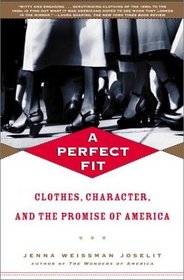Coree B. (Coreegirl) reviewed A Perfect Fit: Clothes, Character, and the Promise of America on + 216 more book reviews
This was a very interesting book, tracing hemlines, men's attire, shoes and jewelery, fitting fashion into larger social trends of the 1880's to 1920's, a peak period of immigration. Fascinating read.
From Library Journal
Broad changes in social attitudes have a corresponding impact in the way we dress the cultural upheaval of the 1960s and 1970s, for example, showed itself in tie-dyed shirts, bell-bottoms, platform shoes, and long hair for both sexes. Joselit (American studies, Princeton Univ.) looks back at an earlier, particularly important period in American history, considering significant changes in both dress and social attitudes from about 1890 to 1925. Broadly speaking, conformity in dress declined, reflecting greater wealth, personal freedom, and social mobility. Women abandoned heavy corsetry and voluminous dresses, for instance, just as they were gaining suffrage. Attentive to the experiences of immigrants and African Americans, the author studies the attitudes of the people, their media, and those in authority toward changes in dress. While Joselit happily does not neglect men's dress, which changed greatly during the period, shifts in children's dress, which reflected transformations in child-rearing attitudes, are omitted from discussion. Well written and researched, this study will reward casual and scholarly readers equally. Recommended for both public and academic libraries. James F. DeRoche, Alexandria, VA
Copyright 2001 Reed Business Information, Inc.--
From Library Journal
Broad changes in social attitudes have a corresponding impact in the way we dress the cultural upheaval of the 1960s and 1970s, for example, showed itself in tie-dyed shirts, bell-bottoms, platform shoes, and long hair for both sexes. Joselit (American studies, Princeton Univ.) looks back at an earlier, particularly important period in American history, considering significant changes in both dress and social attitudes from about 1890 to 1925. Broadly speaking, conformity in dress declined, reflecting greater wealth, personal freedom, and social mobility. Women abandoned heavy corsetry and voluminous dresses, for instance, just as they were gaining suffrage. Attentive to the experiences of immigrants and African Americans, the author studies the attitudes of the people, their media, and those in authority toward changes in dress. While Joselit happily does not neglect men's dress, which changed greatly during the period, shifts in children's dress, which reflected transformations in child-rearing attitudes, are omitted from discussion. Well written and researched, this study will reward casual and scholarly readers equally. Recommended for both public and academic libraries. James F. DeRoche, Alexandria, VA
Copyright 2001 Reed Business Information, Inc.--




